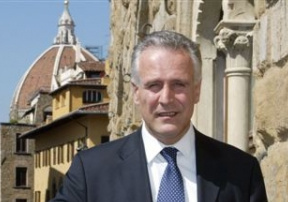


 It is already over twenty years that a group of influential Russian public figures, founders of the Moscow Florentine Society, has been carrying out various cultural projects, intended to better acquaint the people of Russia with Florence and satisfy their growing interest in our city.
It is already over twenty years that a group of influential Russian public figures, founders of the Moscow Florentine Society, has been carrying out various cultural projects, intended to better acquaint the people of Russia with Florence and satisfy their growing interest in our city.
After the fall of the “Iron Curtain,” which had been dividing Europe for more than forty years, such public initiatives as the Moscow Florentine Society proactively participate in the organization of meetings between the East and West, assisting in the fence-mending and construction of a multinational and multicultural Europe. Today, when we see the recurrence of international frictions at the level of central governments, such inter-regional communication has become especially important and significant.
Peter Barenboim, alongside with other distinguished representatives of civil and political circles of today’s dynamically developing Moscow, has played a leading part in the creation of the Moscow Florentine Society.
Being at that time in charge of the City of Florence international relations, I could not help appreciating the reverent zeal with which the Moscow Florentine Society had been preparing the signature of the Memorandum of Co-operation between the Municipality of Florence and Moscow Duma on March 6, 2003.
The choice of that date hardly was accidental since it was the day of the 528th anniversary of Michelangelo’s birth. The ceremony was held in the “Italian Patio” of the Pushkin Museum of Fine Arts in Moscow. This part of the Museum is an imitation of the patio of the Florentine Palazzo del Bargello. This “Italian Patio” contains a life-size copy of Michelangelo's David and replicas of other Florentine sculptures. This not only serves as a vivid proof of the respect the Russian capital feels for Florence — one of the major centres of European civilization and culture, — but also shows the dedication with which outstanding Russian artists and writers of the last two centuries had been engaged in the study of our city and the great masters who had lived and worked here.
Undoubtedly interesting are the publications of the Moscow Florentine Society, which include both memoirs of the Russian visitors to Florence and a new original interpretation of the New Sacristy of the Medici Chapel — an architectural and sculptural masterpiece, immortalizing the memory of Lorenzo the Magnificent and his brother Giuliano.
If Florence is indeed a “dream city” for many Russians, it will be a great honour for us, Florentines, to realize what a deep and beneficial imprint our city has left on the minds of best representatives of the Russian intellectual élite.
It is already as President of the Toscana Regional Council that I received a new proposal from Peter Barenboim to strengthen our friendly ties even more, which led to the signature on March 9, 2016 — also at the initiative of the Moscow Florentine Society — of the Memorandum of Co-operation between the Moscow Duma and Toscana Regional Council. I believe this significant event should lead us to an even greater intellectual cross-pollination.
It is worth mentioning that the Moscow Florentine Society is a one-of-a-kind cultural organization, having no analogs in the world where there are many Florentine communities.
Florence was lucky to miraculously avoid the total destruction during the WWII. The front line ran along the river Arno, dividing Florence in two, but the artillery remained silent. No one dared to open shellfire in the city of Michelangelo, Botticelli and Brunelleschi.
Nevertheless, several bridges and buildings along the banks of the river were demolished by the retreating German troops. I was born already after the war, but in the memory of my smart phone I have pictures of those destroyed houses. Sometimes, looking at these pictures, I feel this is indeed a non-healing wound on the heart of every Florentine. Culture is very fragile, and it requires protection. This is why on a new house, erected near the Ponte Vecchio bridge, on the site of one of the buildings, demolished by the Nazis, a memorial plaque was installed on October 9, 2017. This plaque commemorates Nikolai Roerich, the great Russian philosopher, painter, and public figure, who was the initiator of the Roerich Pact — the first international treaty for protection of cultural property — which was signed in 1935.
Peter Barenboim, currently the Honorary Chairman of the Moscow Florentine Society, is an international lawyer and one of the leaders of the movement to incorporate the ideas of the “Roerich Pact” into the modern UN conventions. As one of the guests invited to attend the plaque opening ceremony, he said that the struggle for the total ban on the destruction of the objects of world culture by the military in the course of hostilities is the most important task of our time. Such destruction cannot be justified by any military necessity.
I believe the topic of legal protection of culture could become a new stage of co-operation between the Florentine public and the Moscow Florentine Society.
President (from 17.02.2021) & Co-Founder: Alexei Kara-Murza.
Honorary Chairman & Co-Founder: Peter Barenboim.
Domestic Vice-Presidents: Alexander Zakharov, Boris Meshcheryakov, Maria Mironova.
International Vice-Presidents: Lolita Timofeeva (Italy), Arthur Heath (USA), Michael Trushin (UK).
On 16 June 2016, the Renaissance courtyard of Palazzo Coppini in Florence (Italy) was intitulated to Ekaterina Y. Genieva (1946-2015), the late Vice-President & Co-Founder of the Moscow Florentine Society.
The Moscow Florentine Society was founded on 17 September 2001 with the aim of promoting and implementing the noble ideas and values of the Italian Renaissance in modern democratic Russia.